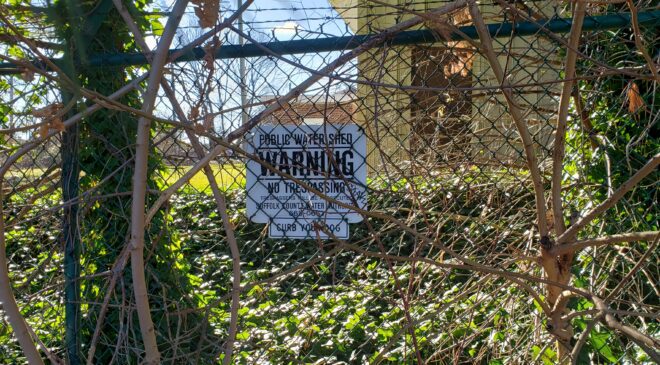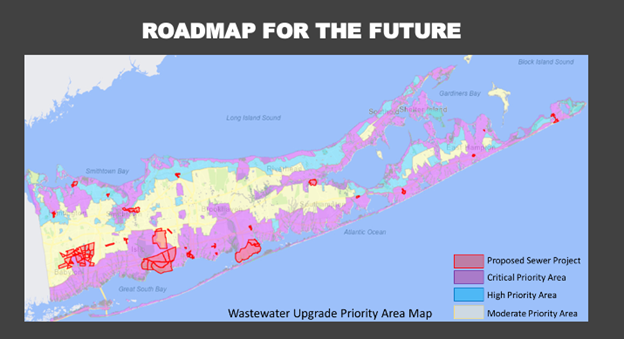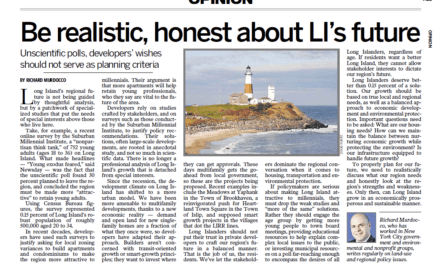The following was exclusively published by The Foggiest Idea on April 25, 2023. Interested in supporting The Foggiest Idea’s award-winning reporting and analysis? Click here.
BY RICHARD MURDOCCO
Because Suffolk County doesn’t have enough public sewers to handle all the wastewater generated by generations of residents and businesses located here, the purity of its underground aquifer has been under constant threat as solutions offered by local elected officials have far too often gone down the drain.
The latest effort involves establishing a wastewater management district that would encompass the entire county, which policymakers believe is a promising way to ensure that there’s enough fresh clean water in our future.
At the same time, Suffolk lawmakers want to impose a new 1/8th of a penny county sales tax to further fund water quality improvement projects – and potentially create a revenue stream for projects within the district itself.
But this proposal comes with a clog: a dedicated Suffolk County tax for water quality has already existed for decades.
And some critics are questioning why more money is needed when they contend that the popular existing program is up to the task of funding the county’s sewer ambitions. They also point to what’s happened before and wonder how the public can trust their Suffolk County executive not to tap into these highly specialized funds to balance the budget if it comes under pressure during uncertain economic times.
Suffolk County officials and sales-tax proponents say that the new surcharge is needed to implement the county’s Subwatersheds Wastewater Plan and finally tackle the county’s ongoing water woes. That ambitious plan was overwhelmingly adopted by the Suffolk County legislature in 2020.
According to these policymakers, Long Island doesn’t have any more time to waste before the pristine quality of its drinking water is washed away forever.

Pictured: A Suffolk County Water Authority property in Commack, NY. Public policymakers are seeking funds to expand sewer infrastructure across Suffolk County. (Photo Source: Richard Murdocco/The Foggiest Idea)
Not surprisingly, a broad assortment of environmental groups, business organizations, trade unions and local civic associations on Long Island support the new 1/8th cent Suffolk sales tax as well as the county-wide sewer district. They argue that both measures are necessary to make it easier to further develop existing sewer networks where appropriate, upgrade existing wastewater infrastructure, and enable individual homeowners to replace their outdated septic systems.
If the Suffolk County Legislature approves the new 1/8th cent sales tax this spring, the tax hike proposal will appear on a ballot referendum for Suffolk voters to consider in this November’s coming election.
Currently, Suffolk residents pay a 1/4th penny sales tax that directly supplies Suffolk County’s Drinking Water Protection Program. The program, which was created to provide funding for open space protection and other water quality initiatives, was adopted by elected officials and overwhelmingly approved by a public referendum in 1987. It has since been renewed by county voters numerous times.
But as the years flowed past, the purported scope of what these protected funds could be used for ballooned to include sewer district tax rate stabilization and property tax mitigation. Suffolk lawmakers’ increasingly liberal use of Drinking Water Protection Program money came to a head when the County opted to use the sewer stabilization funds to fill holes in its budget.
These money moves came under fire in numerous heated lawsuits that were brought forward by the Long Island Pine Barrens Society. The plaintiffs accused Suffolk County of openly raiding the protected funds for uses beyond their intended purpose, and the battle ultimately led to a public referendum on the matter. The courts agreed with the Pine Barrens Society, and the judges compelled Suffolk to repay the misallocated funds.
Despite that determination, the matter is still being litigated. It is alleged that up to two hundred million dollars was misdirected from the County’s protected environmental funds.
Now that Suffolk is again asking voters to approve yet more sewer funding, supporters of the measure don’t seem too concerned about allegations regarding the County’s past transgressions.
In March, New York State legislators passed budget resolutions that would establish a new countywide wastewater management district for Suffolk, as well as create a 1/8th cent county sales tax to fund related water quality improvement projects. Support on Long Island was so strong for these measures in Albany that New York State Senators Alexis Weik (R-Bayshore), Anthony Palumbo (R-Riverhead), Mario Mattera (R-Smithtown) and Dean Murray (R-Patchogue) all signed a letter to Gov. Kathy Hochul urging the Democratic governor to include the new tax in the budget.
That increase would bring Suffolk County’s sales tax rate to 8.75 percent. The rate in nearby Nassau County is lower, at 8.625 percent. In New York City and Westchester County, the rate is 8.875 percent.
Estimates are that the new tax could add 12 cents to a $100 purchase. Policymakers anticipate that raising the drinking water sales tax would generate $57.8 million the first year alone, and that a whopping $3.1 billion could be raised between 2024 and 2060.
For decades Suffolk County Deputy Executive Peter Scully has worked on water issues in a range of Town, County and State roles. These days, as Suffolk County’s “Sewer Czar,” Scully is pushing to get more of the region to treat its wastewater.
“The existing Drinking Water Protection program was not designed and never intended to serve as a source of funding for a long-term infrastructure plan,” Scully recently told The Foggiest Idea. “The current proposal is intended to complement the existing program by providing long-term wastewater infrastructure funds.”
He strongly believes that the additional sales tax money is needed to fund the county’s planned water protection efforts.
“The fund could be used only to pay for infrastructure improvements that result in the elimination of cesspools or septic systems,” he explained. “This includes either connection of additional parcels to sewers or the replacement of existing cesspools or septic systems with new technology.
“The pending bill would limit the amount of funding used for administration of the countywide district to 10 percent of the proceeds of the fund,” Scully added, “guaranteeing that 90 percent would be used for infrastructure improvements guided by the Subwatersheds Wastewater Plan.”

Pictured: This map from Suffolk County highlights key areas identified by policymakers to develop wastewater infrastructure. County data shows there are still 380,000 active cesspools in Suffolk County. (Image Source: Suffolk County)
According to former chief deputy Suffolk County executive Paul Sabatino, who is the original legal architect of the county’s Drinking Water Protection Program, the 1/4th cent sales tax revenues were supposed to be protected from the whims of Suffolk lawmakers. Sabatino, a longtime Suffolk legislative counsel and a still-practicing attorney, finds the notion of creating a new 1/8th sales tax, complete with similar County-promised “protections,” to be audacious, to put it mildly.
“The absurdity of asking voters to increase the sales tax yet again for sewers is crazy, especially after the politicians stole $200 million that is still being litigated in court,” Sabatino fumed to The Foggiest Idea. “If the public knew what was going on, I’d like to think they wouldn’t be fooled again.”
Suffolk County Legislator Anthony Piccirillo (R-Holbrook) expressed his concerns over the impact that sewers will have on development in local communities as well as the budgetary security of the new funds being voted on by the public.
“The new fund could be used to pay for sewer projects in areas like Kings Park, Patchogue and Oakdale,” he said, adding that local builders are excited at the prospect of having more sewers. “It is an undisputed fact that sewers are linked to the appetite for development.”
Piccirillo echoed Sabatino’s concerns about the need to protect the sanctity of any new funding, and that the public needs to be better educated about the mechanics of what a countywide sewer district would look like.
“I have serious concerns whether or not these funds are in the lockbox or not,” Piccirillo said. “Elected officials have shown that they have the appetite to raid these funds to fill budget holes. And before asking for a general tax increase, it should be better defined so this money could only be used for specific purposes.”
Supporters of the proposal claim that the Subwatersheds Plan needs the financial muscle in order to be implemented immediately.
“This plan positions Suffolk to reverse course on decades of declines in drinking and surface water quality and to make a generational investment in the health and well-being of our children and their children,” recently wrote Dr. Christopher J. Gobler, a professor in the School of Marine and Atmospheric Sciences at Stony Brook University, in Newsday. Gobler, who has an endowed chair of Coastal Ecology and Conservation, stressed the science behind the plan’s effort, and that it was designed to offer maximum environmental benefit to the public. In his op-ed, he urged passage of the new tax to fund the program’s recommendations.
As Executive Director of Citizens Campaign for the Environment, a not-for-profit organization based in New York, Adrienne Esposito has been actively working on local water quality issues for decades. She told The Foggiest Idea that the funding structure for the current Drinking Water Protection Program does not account for the deployment of new technological wastewater solutions, such as advanced septic systems. Environmental advocates regard these newer systems as being essential to cutting down nitrogen pollution in the region’s drinking water at a lower cost compared to outright sewering swaths of Suffolk neighborhoods.
“Right now, the county uses a small portion of the existing fund for septic replacements,” Esposito said. “When the legislation first allocated these funds in the 1980s, that technology wasn’t even dreamed of.”
She claimed that concerns that the County might misuse the new water protection funds were overblown.
“We can’t base every decision on the fear there will be a misstep,” Esposito said. “Then we’ll never go anywhere.”
As it stands, county data shows that nearly 75 percent of Suffolk homes have traditional septic systems or cesspools, and that the collective wastewater from these households accounts for 63.6 percent of the nitrogen within our groundwaters. According to Suffolk County officials, there are still 380,000 active cesspools in Suffolk County, and 20,000 of them are on commercial properties.
According to Scully, Suffolk’s “Sewer Czar,” if the county-wide wastewater management district is established, Suffolk’s existing 27 sewer districts would be consolidated into a single zone of assessment, which would “eliminate the redundancies inherent in having 27 individual districts” and provide “increased efficiency.” Scully pointed out that only owners of properties that are connected to the county sewer plants would be billed for sewer services, and that all freestanding Town and Village sewer districts would be excluded from the newly minted unified district.
To Esposito, the connected proposals of consolidating the sewer districts and imposing a new Suffolk sales tax fee are a no-brainer.
“The bottom line is that clean water benefits everybody,” Esposito insisted. “This is not a political issue, but a public health issue. In the 21st century we should be treating our wastewater. Our existing systems are so archaic. It is not only embarrassing, but dangerous.”
Richard Murdocco is an award-winning columnist and adjunct professor in Stony Brook University’s public policy graduate program and School of Atmospheric and Marine Sciences. He regularly writes and speaks about Long Island’s real estate development issues. Follow him on Twitter @thefoggiestidea.












